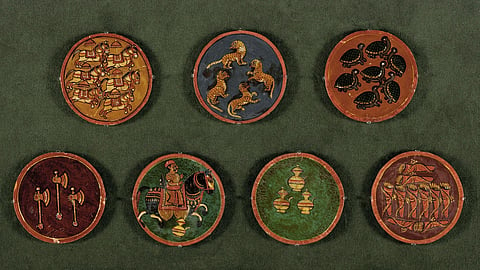
- HOMEGROWN WORLD
- #HGCREATORS
- #HGEXPLORE
- #HGVOICES
- #HGSHOP
- CAREERS
- ABOUT US
- CONTACT US

Ganjifa is a captivating card game originating from Persia that has transcended time and borders to become a cherished emblem of status and sophistication, particularly during the illustrious Mughal era in India. Its name, derived from the Persian word ganj, meaning treasure or wealth, exemplifies the rich cultural heritage and history woven into each intricately hand-painted card.
The primary allure of Ganjifa lies in the exquisite craftsmanship of its cards. Unlike the rectangular West Asian cards that we are quite accustomed to, Indian Ganjifa cards are fashionably circular. Each circular card served as a canvas for master artisans, who painstakingly adorned them with vibrant colors and intricate designs.
These miniature works of art depict figures, symbols, and scenes drawn from mythology, folklore, and the imperial courts, offering a visual feast for the eyes and a window into a bygone era of opulence and refinement. The packs used by the Mughal royal court were crafted with valuable materials such as tortoiseshell and ivory, while the playing decks for the general populace were made with starched cloth, palm leaf or papier mache or, often with a varnished exterior.
While the visual splendor of Ganjifa cards is undeniable, the game itself offers a rich exercise of strategy and intellect not unlike chaturanga, the world-famous Indian game that eventually evolved into modern-day chess.
In MAP Academy’s Encyclopedia of Art, the rules of Ganjifa are explained soundly: The pack consists of two parts, or bhedas, each containing four suits with two court cards called shah (king) and wazir (minister), as well as numerical cards from one to ten. The court cards of each suit are the strongest. The bishbar bheda has ten as its strongest number card and one as its weakest, while the kambar bheda is reversed, with one being the strongest.
The suits are named gulam (servant), taj (crown), shamsher (sabre, or curved sword), and tanka (silver coin) in the bishbar bheda, and barat (cheque or draft), qimash (material wealth, usually in the form of textiles), ashrafi (red or gold coin), and chang (a small harp) in the kambar bheda. Ganjifa challenges players to outmanoeuvre their opponents through cunning and skill. While the rules vary across different versions of the game, they all emphasise strategy, tactics, and a deep understanding of card combinations and probabilities.
A typical game of Ganjifa involves three players and is played in three rounds. The game aims at winning tricks and accumulating points. In each round, players need to form winning hands or tricks. The player with the lowest score is required to exchange their high cards for low cards in the next round. This exchange of cards adds an element of strategy and unpredictability to the game, keeping players engaged and challenged throughout. Read the detailed rules of gameplay here.
Despite its waning popularity in modern times, Ganjifa's legacy endures, kept alive by dedicated artisans, enthusiasts, and scholars who recognize its cultural significance and historical importance. While novelty packs occasionally grace the shelves of collectors and museums, the spirit of Ganjifa lives on in the enchanting land of Odisha through the iteration of the trick-taking card game, Ganjapa.
